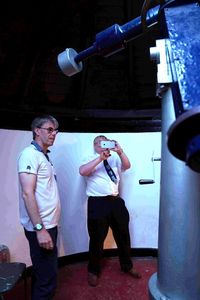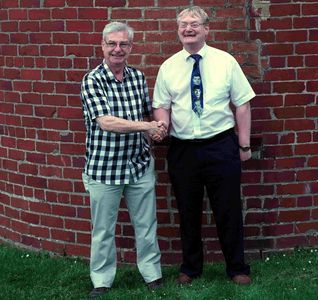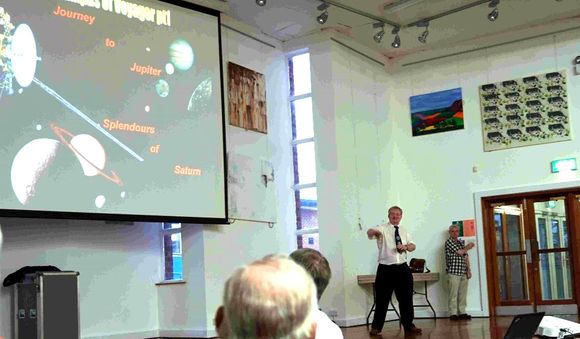After a three year break Paul returned to Whitby to give the presentation he was due to give last year, but had to pull out due to family illness. For once his trip was less susceptible to the worst of the weather, yet despite being a settled warm weather period, Mother Nature still tried to rain on our parade, but i think we got away with it.
Paul arrived in good time at the college, which was utilised marrying up his IT equipment with the IT system in the main hall... we eventually won. There was then just time to show Paul the observatory and take some pictures, something we had been meaning to do for quite a few years. Paul was delighted to see the Cooke refractor, and took quite a few pictures himself.


Mark and Paul in Whitby Observatory, Andy Lawrence and Paul outside it.
The venue – the main Hall at the college, had been kindly offered for our use – many thanks to them and society member Keith – who works at the college in making this happen.
By 19:30h Paul was ready. It was great to see so many members, both past and present come along for Paul’s presentation, and there were a healthy number of non society members, some of whom expressed an interest in joining.
Paul’s talk was entitled "Triumphs of Voyager – Journey to Jupiter and the splendours of Saturn"
Paul explained that as far back as the 1960’s the maths was worked out showing how a spacecraft could be dispatched to the outer planets using planetary gravity assists. A window of opportunity would be available during the latter seventies, and would not occur again for another 176 years.

Paul giving his lecture on the Triumphs of Voyager
Eventually, NASA secured funding for the Mariner/Jupiter Saturn project, which became the Voyager missions, launching two craft: Voyager 1 and 2 in 1977. Voyager 2 was actually launched first in August, followed a month later by Voyager 1.
Voyager 1 was to fly by Jupiter and onto Saturn – passing its primary target Titan at close range. Voyager 1 would then leave the solar system (in a very long time) Voyager 2 following on the heels of 1 would visit Jupiter, then Saturn and onto the outer gas giants of Uranus and Neptune. (that’s part two of Paul’s talk on the voyages)
It was fascinating to learn how engineers were able to maintain contact; solving problems connected with trajectory motors and scientific payload arms en route. Paul showed a number of images of Jupiter and the Galilean moons, including the erupting volcanic world of Io, something which totally confounded planetary scientists. It was the ‘unexpected’ discoveries made by Voyager which revolutionised thinking of planetary satellites in particular, and paved the way for the spectacular successes of the Galileo and Cassini missions later on.
Our customary refreshments break almost didn’t happen, problems with Kitchen access, missing cups, plates, and saucers could have scuppered supper, fortunately matters were resolved and the delicious sausage rolls, homemade cheese scones and micro pizza squares made by Mark’s wife Vicky were pretty much cleaned out. A big ‘thank you’ also to Rosy, who had travelled over from Kirbymoorside, and aided admirably during the refreshment break.
The talk concluded with some stunning images of Saturn and its major moons; including an enhanced image of Enceladus in which if you looked carefully the now famous water jets could be made out, something missed at the time. Questions and answers followed, before we thanked Paul once again and hoped to see him next year, a date already tentatively pencilled in.
Thanks again to everyone who came along – hope to see you next year... if not sooner.
- Log in to post comments
